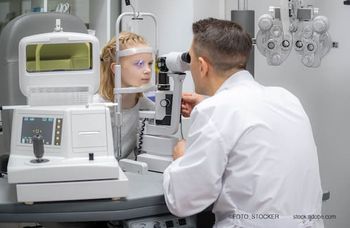
LIGHTSITE III trial data demonstrates improvement in vision in intermediate dry AMD
LumiThera Inc. noted that the trial results demonstrated statistically significant improvement in the prespecified primary endpoint in BCVA at 13 months in the PBM treatment group over the sham-treatment group.
LumiThera Inc. today announced detailed findings in its LIGHTSITE III, multi-center clinical trial in non-neovascular (dry) Age-Related Macular Degeneration (AMD) subjects treated with Photobiomodulation (PBM) using the Valeda Light Delivery System.
According to the company, LIGHTSITE III, a prospective, double-masked, randomly assigned, multi-center clinical trial, was conducted at 10 leading US retinal centers. The goal was to treat non-neovascular (dry) AMD subjects with PBM every four months for a duration of 24 months.
The company noted in a news release that 100 subjects were enrolled in a 2:1 ratio of PBM to sham in the treatment groups. The mean age was 75 years and mean dry AMD duration since diagnosis was 4.9 years prior to trial enrollment. Baseline best corrected visual acuity (BCVA) letter scores observed were a mean + SEM of 69.4 + 0.8 and 70.1 + 0.7 in the sham and PBM treatment groups, respectively.
The majority of subjects were considered to have intermediate dry AMD. The analysis included 91 eyes in the PBM treatment group and 54 eyes in the sham treatment group in the modified intent to treat population.
The trial results demonstrated statistically significant improvement in the prespecified primary endpoint in BCVA at 13 months in the PBM treatment group over the sham-treatment group (p = 0.02). A sustained, mean increase in ETDRS letter score of ~5.5 letters from baseline was seen at the 13-month timepoint in PBM-treated subjects (p < 0.0001). In the PBM treatment group responders, 55% of the subjects showed a >5 letter improvement on the standard EDTRS eye chart with a mean of 9.7 letters and 26% achieved a >10 letter improvement with a mean of 12.8 letters.
In addition to improvements in BCVA, anatomical measurements in PBM-treated subjects demonstrated no significant increase in drusen pathology at 13 months compared to baseline while sham subjects continued to see numerical increases in drusen deposition. Drusen deposition is the hallmark pathology for diagnosis of dry AMD which leads to chronic inflammation and is associated with disease progression and cell loss. A negative correlation was observed between lower drusen volume pathology and improvement in BCVA with PBM (Spearman correlation, -0.3, p = 0.004).
The advance to later stage disease pathology such as the neovascular (wet) form or the development of geographic atrophy (GA), i.e., loss of retinal tissue in naïve patients was evaluated. The % conversion of dry AMD to the wet form was 1.8% for sham, 5.4% for PBM and 8.3% for the non-study eye groups at month 13. A few patients had GA (9 eyes at screening), and were distributed evenly between 5 PBM and 4 sham eyes at baseline. At month 13, 6 additional eyes progressed with new GA identified. Overall, a total of five of 55 sham eyes progressed to new GA (9.1%) versus only 1 of 93 PBM eyes progressed to new GA (1.1%) at month 13.
"The subjects had good starting vision with approximately 70% having between 20/32 to 20/40 vision.
According to Diana Do, MD, and Quan Dong Nguyen, MD, MSc, FARVO, both professors of ophthalmology and members of the Retina Division at the Byers Eye Institute at Stanford University, a clinical site for the LIGHTSITE III trial, study subjects were only enrolled in the study if their vision was 20/32 to 20/100 and no evidence of GA in the central macula.
“Intermediate dry AMD patients have pathology and visual impairment consistent with earlier stages in the disease and have not lost retinal tissue by progressing to GA,” the pair noted in the news release. “Thus there is an opportunity to improve their vision while retinal tissue is still viable. Therapy with PBM using the Valeda Light Delivery System may serve a significant unmet need for many of our patients with dry AMD who now have the potential to improve their visual acuity with treatment”
Moreover, René Rückert, MD, MBA, chief medical officer of LumiThera, pointed out in the news release that the safety results from the LIGHTSITE III trial through the 13-month timepoint were positive.
“We now have patients that have exited the 2 year study,” Rückert explained. “We will continue to follow all patients for the full 24 months for safety. To date, the results are consistent with a very favorable safety profile and a non-invasive treatment that can target patients earlier in disease.”
Eleonora Lad, MD, PhD, an associate professor and director of ophthalmology clinical research at Duke UniversityMedical Center, a participating site, moted that a non-invasive approach such as PBM treatment with the light delivery system could have a potential impact on the quality of life for dry AMD patients.
“We have many patients that would be excited to benefit from any treatment that recovers or improves vision,” she said in the news release.
Glenn Jaffe, MD, Robert Machemer Professor of Ophthalmology and chief, Vitreoretinal Division and director of the Duke Reading Center, pointed out that the clinical results show improvements in vision.
What is further interesting is the lack of drusen deposit in the PBM treated group, and potentially less patient conversions to wet form of disease,” Jaffe noted in a statement. “Patient progression to new GA was also evaluated and was less in the PBM group, and while the new GA progression numbers are small in this study group, all outcomes point in favor for PBM as a novel approach to treat dry AMD patients earlier in disease.”
Clark Tedford, PhD, president and CEO of LumiThera, pointed out in the news release that the study supports that PBM treatments can improve visual acuity.
“Our commercial and clinical trial experience has demonstrated an excellent safety and clinical benefit profile and we plan on submitting a PMA to the FDA for U.S. approval,” Tedford noted.
Newsletter
Don’t miss out—get Ophthalmology Times updates on the latest clinical advancements and expert interviews, straight to your inbox.



















































.png)


